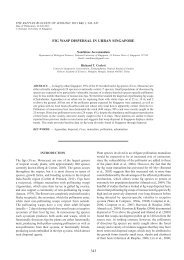1O257LF
1O257LF
1O257LF
You also want an ePaper? Increase the reach of your titles
YUMPU automatically turns print PDFs into web optimized ePapers that Google loves.
© 2010 Dinosauria International Ten Sleep Report Series No. 1<br />
A<br />
Fig 18 A-C Partially exposed skull and lower jaws belonging to<br />
DQ-PE. A. Caudal view of the braincase is in the upper left corner,<br />
and prezygapophysis and centrum can be seen in the middle (see<br />
arrow). B. Close up of teeth found with skull. C. Distal caudal vertebrae<br />
from the associated skeleton.<br />
B<br />
C<br />
were all found articulated to each other. The 14 th cervical<br />
was in direct contact but not articulated, while the 15th was<br />
unearthed several feet away, near the pelvis. Thus, the bones<br />
of the head and neck in this individual are captured as they<br />
were in life. Interestingly, most of the neck vertebrae were<br />
preserved locked in a straight row except for the last six<br />
which are noticeably flexed in articulation. Moreover, the<br />
ends of the centra incline, and suggest that the neck was<br />
held normally in a somewhat flexed position.<br />
The pelvic elements (Fig 7) were also preserved<br />
together in semi-articulation along with five fused sacral<br />
vertebrae. The sacral elements and the adjoining dorsals<br />
(D 9 & 10) suffer from considerable post-mortem distortion<br />
due to compression. In DQ-BS, the transverse processes<br />
on the anterior caudal vertebrae are present from C 1-16 .<br />
The massive limbs are preserved complete and uncrushed<br />
without deformity, adding greatly to the skeleton’s<br />
impressive appearance. Associated sets of foot bones,<br />
including claws, were also recovered. Only the right scapula<br />
and the whiplash section of the tail vertebrae are noticeably<br />
absent. However, ongoing excavations may eventually<br />
expose them. Two pairs of mid caudal vertebrae are fused.<br />
Our quarry map (Fig 8) illustrates the close distribution of<br />
the bones belonging to this associated skeleton.<br />
DQ-TY = “Twinky”, Figs: 9-13, 24, 28 A, and 32<br />
The Dana Quarry has yielded magnificent dinosaur<br />
remains. One specimen, nicknamed “Twinky” (DQ-TY), is<br />
especially noteworthy due to its small size and exquisite<br />
preservation. Discovered in the spring of 2009, this new<br />
diplodocid is both the first specimen possessing a nearly<br />
complete axial skeleton with associated limbs and belonging<br />
to an individual half the size of the others in the quarry.<br />
Twinky may possibly represent the stage of life of an<br />
adolescent individual. There are no comparable specimens<br />
housed in museum collections quite like DQ-TY. In complete<br />
paleontological context, as part of a population sample, this<br />
exceptional specimen offers unique opportunities to study<br />
ontogenetic development in sauropods.<br />
20



